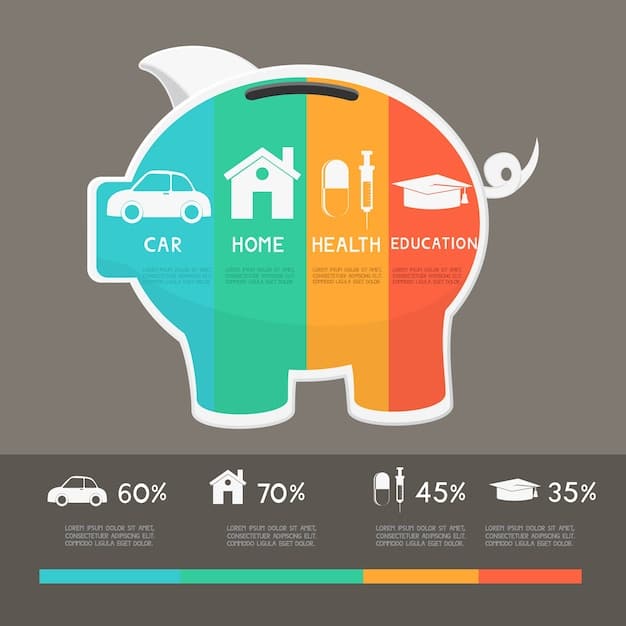Maximize Life Insurance Benefits: A Guide for Beneficiaries in the US

Anúncios
Life insurance benefits provide financial security to beneficiaries upon the policyholder’s death; understanding policy options and how to maximize payouts is crucial for effective financial planning and ensuring loved ones are well-protected.
Understanding life insurance benefits is essential for both policyholders and beneficiaries. This guide delves into various policy options and strategies to maximize payouts, ensuring financial security for your loved ones in the US.
Anúncios
Understanding Life Insurance Policy Types
Life insurance policies come in various forms, each designed to meet different needs and financial goals. Knowing the distinctions is crucial for selecting the right coverage and optimizing the benefits for your beneficiaries.
Term Life Insurance
Term life insurance provides coverage for a specific period, typically ranging from 10 to 30 years. If the policyholder dies within this term, the beneficiaries receive the death benefit.
Anúncios
Whole Life Insurance
Whole life insurance offers lifelong coverage, as long as premiums are paid. It also includes a cash value component that grows over time, providing an additional financial benefit.
- Term Life: Affordable, fixed duration, ideal for specific needs.
- Whole Life: Lifelong coverage, cash value accumulation, higher premiums.
- Universal Life: Flexible premiums, adjustable death benefit, cash value component.
- Variable Life: Investment options for cash value, potential for higher growth, risk involved.

Selecting the right type of life insurance is a significant decision that depends on your financial situation, long-term goals, and risk tolerance. It’s advisable to consult with a financial advisor to determine the best option for your specific circumstances.
Navigating Policy Riders and Endorsements
Policy riders and endorsements are additional provisions that can customize a life insurance policy to better fit individual needs. These features can enhance the policy’s benefits and provide extra layers of protection.
Accelerated Death Benefit Rider
An accelerated death benefit rider allows the policyholder to access a portion of the death benefit while still alive if diagnosed with a terminal illness.
Waiver of Premium Rider
The waiver of premium rider waives premium payments if the policyholder becomes disabled and unable to work.
- ADB Rider: Access funds during terminal illness.
- Waiver of Premium: Premium waived during disability.
- Accidental Death: Additional payout for accidental death.
Review your policy carefully to understand any riders or endorsements included, and how they can impact the benefits available to your beneficiaries. Consider adding riders that address specific concerns or financial vulnerabilities.
Maximizing Payouts: Strategies for Beneficiaries
Beneficiaries can take several steps to maximize the value of life insurance payouts. Proper planning and understanding of available options can significantly enhance the financial security provided by the policy.
Lump-Sum vs. Annuity Payments
Beneficiaries typically have the option to receive the death benefit as a lump sum or as annuity payments. Each option has its own advantages and implications.
Managing Beneficiary Designations
Keep beneficiary designations up to date and clearly defined. Include primary and contingent beneficiaries to ensure the payout goes to the intended recipients.
Understanding how to effectively manage and utilize the life insurance payout can secure your financial future. It’s beneficial to strategize and seek guidance from a financial advisor to make the most of these resources.
Understanding Tax Implications of Life Insurance Benefits
Life insurance benefits are generally income tax-free to the beneficiaries, but it’s essential to understand the potential tax implications related to estate taxes and other financial considerations. Understanding these aspects ensures that beneficiaries can fully benefit from the insurance payout without unexpected tax burdens.
Federal Estate Taxes
Life insurance proceeds can be included in the policyholder’s estate for federal estate tax purposes, especially if the estate exceeds certain thresholds. Estate taxes can significantly reduce the amount ultimately available to heirs.
State Inheritance Taxes
Some states impose inheritance taxes on the beneficiaries, depending on their relationship to the deceased. Being aware of state inheritance taxes helps in planning for potential tax liabilities.

- Estate Tax Planning: Consult with a tax advisor for strategies to minimize estate taxes.
- Irrevocable Life Insurance Trust (ILIT): Consider placing the policy in an ILIT to remove it from the taxable estate.
- Minimize Tax Burden: Proper planning helps reduce potential tax implications on life insurance benefits.
Navigating the tax landscape surrounding life insurance benefits requires careful planning and expert advice. By understanding these tax implications and working with qualified professionals, policyholders and beneficiaries can optimize the financial benefits of life insurance.
Common Mistakes to Avoid When Claiming Benefits
Claiming life insurance benefits can be a straightforward process, but it’s essential to avoid common mistakes that could delay or complicate the payout. Addressing these pitfalls ensures a smoother and more efficient experience for beneficiaries.
Incorrect Paperwork
Submitting incomplete or inaccurate paperwork is a frequent cause of delays. Double-check all forms and documentation before sending them.
Lapsed Policies
Ensure the policy is active and in good standing at the time of the policyholder’s death. A lapsed policy means no benefits will be paid.
- Accurate Information: Provide complete and correct information on all claim forms.
- Timely Submission: Submit the claim promptly after the policyholder’s death.
- Policy Review: Review the policy details to understand the terms and conditions.
By being diligent and proactive, beneficiaries can avoid common pitfalls and ensure a timely and accurate payout of life insurance benefits. Careful attention to detail and prompt communication with the insurance company can streamline the claims process.
The Role of a Financial Advisor in Maximizing Benefits
A financial advisor can play a crucial role in helping policyholders and beneficiaries navigate the complexities of life insurance. Their expertise can ensure that policies are optimized and benefits are managed effectively to achieve long-term financial goals.
Policy Optimization
Financial advisors can help policyholders select the right type and amount of life insurance based on their financial needs and goals.
Estate Planning
Advisors can assist in estate planning to minimize taxes and ensure that life insurance benefits are distributed according to the policyholder’s wishes.
- Customized Advice: Tailored recommendations based on individual financial situations.
- Comprehensive Planning: Integration of life insurance into broader financial and estate plans.
- Ongoing Support: Continuous guidance and adjustments as financial circumstances change.
Engaging a financial advisor offers valuable expertise and support, ensuring that life insurance benefits are maximized and integrated into a comprehensive financial strategy. Their guidance can provide peace of mind and long-term financial security for policyholders and beneficiaries.
| Key Point | Brief Description |
|---|---|
| 📝 Policy Types | Term, whole, universal, and variable life insurance options. |
| ➕ Riders | Enhance policies with accelerated death benefit or waiver of premium. |
| 💸 Maximize Payouts | Consider lump-sum vs. annuity and update beneficiary designations. |
| 🛡️ Avoid Mistakes | Ensure correct paperwork and a policy in good standing. |
FAQ
▼
Term life insurance covers a specific period, while whole life provides lifelong coverage and includes a cash value component that grows over time with ongoing payment of premiums.
▼
A financial advisor can provide tailored advice on policy selection, estate planning, and benefit management to maximize the value of life insurance and customize the needs appropriately.
▼
Common mistakes include submitting incorrect paperwork, having a lapsed policy, and not understanding the policy terms. Always double-check information and keep the policy active.
▼
Life insurance benefits are generally income tax-free but can be subject to estate or inheritance taxes. Consulting a tax advisor helps in planning for potential tax liabilities and minimizing them.
▼
An accelerated death benefit rider allows the policyholder to access a portion of the death benefit while still alive if diagnosed with a terminal illness, helping cover medical expenses.
Conclusion
Understanding life insurance benefits, policy options, and strategies to maximize payouts is crucial for both policyholders and beneficiaries. By making informed decisions and seeking professional guidance, you can ensure financial security and peace of mind for your loved ones. Remember, life insurance benefits are a powerful tool for protecting your family’s future.





